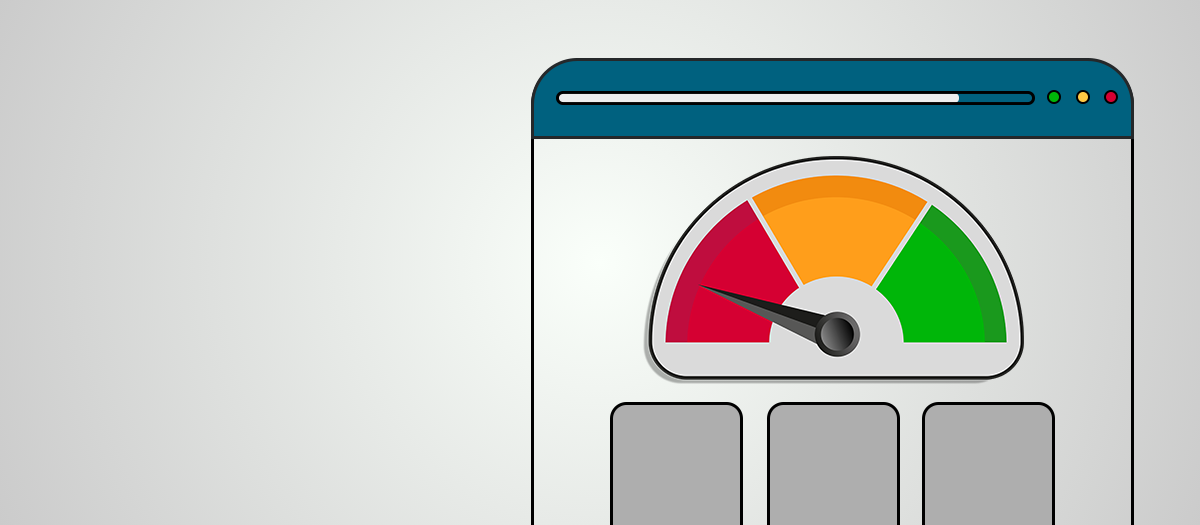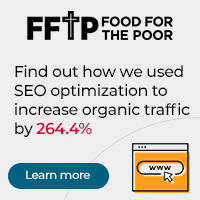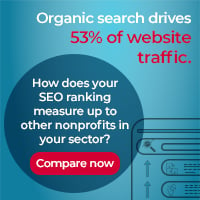Overall Findings
The speed with which a website loads pages plays a critical role in two areas: UX and SEO.
Website visitors expect a smooth, quick user experience on both desktop and mobile. Google is also increasingly emphasizing performance in how it ranks websites in search results.
For these reasons, Google created its PageSpeed Insights tools, which evaluates how websites score in a variety of metrics related to how quickly a webpage loads. RKD Group used this tool to analyze more than 2,000 regional, national and international nonprofit websites. Our goal was establishing the industry's first benchmark for nonprofit website performance standards.
The results of our analysis were quite shocking:
-
-
- 80% of nonprofit websites received a "poor" rating on mobile performance
- 86% of nonprofit websites "need improvement" on desktop performance
-
While nonprofit websites have made a lot of progress in areas like search engine optimization (SEO) and web accessibility, the user experience is being hampered by pages that take too long to load.
Read on to see how different nonprofit sectors stack up in key website performance areas, as well as related areas like accessibility, SEO and best practices.
Key terms to know
Throughout the report, we'll utilize the following terms:
Accessibility score: This measures how well a website works for the diverse needs of all users, including those with disabilities or impairments. Accessibility concerns include vision, motor/dexterity, auditory and cognitive.
Best Practices score: This is calculated through a series of mini-audits that look for script errors, cybersecurity measures, image ratios, font options and more.
First Contentful Paint (FCP): This metric marks the first point at which the user can see anything on the screen, and it is one of six measurements in the Performance score. A fast FCP should load in 1.8 seconds or less.
Largest Contentful Paint (LCP): This metric marks the point at which the page's largest content has likely loaded, and it is one of six measurements in the Performance score. A fast LCP should load in 2.5 seconds or less.
Performance score: This averages five key metrics to measure the speed with which a webpage loads. Included in this score are First Contentful Paint, Speed Index, Largest Contentful Paint, Total Blocking Time and Cumulative Layout Shift.
SEO score: This checks that your page is following basic search engine optimization advice, like having proper meta and alt tag information, a valid robots.txt file and crawlable links.
Speed Index: This metric shows how quickly the contents of a page are visibly populated, and it is one of six measurements in the Performance score. A fast Speed Index should load in 3.4 seconds or less.
Page Speed Scores
Overall Performance Scores
Google's Performance score weighs five metrics to calculate a score out of 100 for each webpage it evaluates. Much like school grades, 90 and above gets an A. Sites scoring below 90 need improvement - and if your site scores below 50, it gets a failing grade of Poor.
Unfortunately for the nonprofit industry, only 14% of websites got a Good score on desktop performance. The remaining 86% of nonprofit websites need some improvement, with 14% receiving a Poor score.
It gets uglier when we look at mobile performance. A scant 1% received the top score, leaving 19% scoring "Needs Improvement"—and a whopping 80% with a failing mark of Poor.
Performance by Nonprofit Sector
On desktops, the results were a mixed bag.
Highest percentage of Good Performance ratings on desktop:
-
-
- 16.6% Rescue Mission
-
-
-
- 15.9% Relief & Development
- 15.6% Health & Disease
-
Yet those three groups also had a greater-than-average percentage of Poor marks.
Lowest percentage of Poor Performance ratings on desktop:
-
-
- 3.6% Service Animals
- 9.4% Hospital
- 10.0% Veterans
-
And again, all three had a lower-than-average percentage of Good marks.
Performance marks were low for every sector when it comes to mobile devices. Faith-based was the only sector to sit above 2% in Good ratings.
Highest percentage of Good Performance ratings on mobile:
-
-
- 2.3% Faith-based
- 1.7% Food Bank
- 1.4% Education & Culture
-
Lowest percentage of Poor Performance ratings on mobile:
-
-
- 76.9% Health & Disease
- 77.2% Rescue Mission
- 77.4% Hospital / Education & Culture
-
All in all, the results show a wide range of variance within each sector. The Rescue Mission sector, for example, had the highest percentage of both Good and Poor ratings on desktops, and they were among the better performing sectors on mobile.
Conclusion: The vast majority of nonprofit websites in every sector need performance improvements, especially when it comes to loading pages on mobile devices.
First Contentful Paint Scores
A big factor that affects the user experience is how long it takes for the first piece of content on a page to load. If a website lags for too long before images and text begin to appear, users will leave the page and navigate elsewhere.
First Contentful Paint (FCP) is a measure of just how long it takes for that first item to appear on the page. Webpages loading that first item in less than 1.8 seconds received a Good rating, while those taking 1.8 to 3 seconds received Needs Improvement. Pages that took more than 3 seconds netted a Poor rating.
On desktops, 7.6% of nonprofit organizations scored a Good rating, while only 1.5% got a Poor rating. The remaining 91.0% fell in the middle, a larger group than for the overall Performance scores.
Once again, mobile scores were much harsher, mirroring the overall Performance scores. Only 3.2% received a Good rating, while 80.7% scored a Poor mark.
First Contentful Paint by Nonprofit Sector
On desktop, the vast majority of organizations across all sectors fell somewhere in the middle of "needing improvement." On mobile, more than two-thirds of organizations in every sector received a Poor score.
Both the Veterans and Relief & Development sectors did well at avoiding Poor scores in both desktop and mobile. The Food Bank sector received above average scores on mobile.
Highest percentage of Good FCP ratings on desktop:
-
-
- 17.9% Service Animals
- 12.8% Social Services
- 11.9% Rescue Mission
-
Lowest percentage of Poor FCP ratings on desktop:
-
-
- 0.0% Relief & Development
- 0.0% Service Animals
- 0.0% Veterans
-
Highest percentage of Good FCP ratings on mobile:
-
-
- 4.7% Education & Culture
- 4.5% Faith-based
- 3.4% Food Bank
-
Lowest percentage of Poor FCP ratings on mobile:
-
-
- 70.0% Veterans
- 75.0% Relief & Development
- 75.7% Food Bank
-
Conclusion: With 92.5 percent of nonprofit websites needing improvement on FCP for desktops and 80.7 percent scoring a Poor rating on mobile, it's clear that this is a big issue. FCP scores are lower for sites that have slow servers, too many page redirects and/or long text files.
Largest Contentful Paint Scores
Waiting for a large image to load on a page can greatly hamper the user experience.
Largest Contentful Paint (LCP) is a measure of just how long it takes for the largest item to appear on the page. Webpages loading that first item in less than 2.5 seconds received a Good rating, while those taking 2.5 to 4 seconds received Needs Improvement. Pages that took more than 4 seconds netted a Poor rating.
On desktops, 26.7% of nonprofit organizations scored a Good rating, while 23.6% got a Poor rating. The remaining 49.7% fell in the middle, needing some improvement. These numbers are far more polarized than the Performance of FCP scores.
Once again, mobile scores were much harsher. Only 4.2% received a Good rating, while 94.7% scored a Poor mark. This makes sense considering a large image would have a much greater impact on speed when loading on a mobile device.
Largest Contentful Paint by Nonprofit Sector
On desktop, we see a good variety of numbers across sectors. On mobile, at least 90% of organizations in every sector received a Poor score.
The Veterans and Hospital sectors stood out on both desktop and mobile. Service Animals also did well on desktop.
Highest percentage of Good LCP ratings on desktop:
-
-
- 50.0% Veterans
- 39.3% Service Animals
- 32.8% Hospital
-
Lowest percentage of Poor LCP ratings on desktop:
-
-
- 14.3% Service Animals
- 15.7% Hospital
- 15.9% Relief & Development
-
Highest percentage of Good LCP ratings on mobile:
-
-
- 10.0% Veterans
- 6.8% Hospital
- 6.8% Relief & Development
-
Lowest percentage of Poor LCP ratings on mobile:
-
-
- 90.0% Veterans
- 92.3% Hospital
- 92.7% Rescue Mission
-
Conclusion: Far too many nonprofit organizations have oversized images on their pages and should focus on resizing images to fit the exact specifications on the page.
Speed Index Scores
FCP and LCP examine the loading speed of the first and largest elements on the page, respectively. Speed Index looks at how long the whole page takes to load.
Webpages that load in less than 3.4 seconds received a Good rating, while those taking 3.4 to 5.8 seconds received Needs Improvement. Pages that took more than 5.8 seconds netted a Poor rating.
On desktops, 15.5% of nonprofit organizations scores a Good rating, while only 5.0% got a Poor rating. The remaining 79.5% fell in the middle, needing improvement.
In a familiar tune, mobile scores were significantly worse. Only 16.7% received a Good rating, while 80.2% scored a Poor mark.
Speed Index by Sector
Most sectors fell into a similar pattern for scores. A few did stand out, however.
On desktops, rescue missions and social services organizations had very polarizing numbers - showing the gap between the haves and have-nots when it comes to websites. We also see that Relief & Development and Service Animals had no organizations with Poor ratings among the ones evaluated.
On mobile, the Veterans sector was head and shoulders above the rest, followed by Hospital and Education & Culture.
Highest percentage of Good Speed Index ratings on desktop:
-
-
- 26.0% Social Services
- 21.2% Rescue Mission
- 16.5% Faith-based
-
Lowest percentage of Poor Speed Index ratings on desktop:
-
-
- 0.0% Relief & Development
- 0.0% Service Animals
- 2.3% Environmental
-
Highest percentage of Good Speed Index ratings on mobile:
-
-
- 30.0% Veterans
- 19,6% Hospital
- 19.4% Education & Culture
-
Lowest percentage of Poor Speed Index ratings on mobile:
-
-
- 70.0% Veterans
- 76.6% Hospital
- 76.9% Education & Culture
-
Conclusion: Since Speed Index accounts for how long it takes for all elements on the page to load, it includes both the first (FCP) and largest (LCP) content items. Thus, it's not surprising to see these scores sit somewhere between the two. Similarly, recommendations like resizing images, cutting down on redirects and improving server speed all apply here as well.
Additional Scores
Accessibility Scores
Google goes beyond just page speed to measure additional factors that can affect the user experience. This includes how well a website fits the diverse needs of all users, including those with disabilities or impairments.
On desktops, just over a third of nonprofit websites (36.3%) received a Good rating for web accessibility. Even better news it that only 1.0% received a Poor rating. Unlike the page speed scores, the numbers on mobile were similar: 33.9% received a Good rating, while 1.2% got a Poor rating.
Accessibility by Sector
Breaking down scores by sector, we see that the Service Animals, Hospitals and Health & Disease sectors registered the best scores.
This makes logical sense in that service animal organizations typically help people with vision impairment, while hospitals and other health nonprofits deal with medical conditions of all kinds. It was surprising, however, to see that the Veterans sector ranked lowest in accessibility.
Highest percentage of Good Accessibility ratings on desktop:
-
-
- 53.6% Service Animals
- 44.7% Hospital
- 43.5% Health & Disease
-
Highest percentage of Good Accessibility ratings on mobile:
-
-
- 50.0% Service Animals
- 42.6% Hospital
- 38.8% Health & Disease
-
Conclusion: If we take the glass half-empty approach here, 62.7% of nonprofit websites still need improvement in web accessibility on desktops. Roughly 61 million adults in the U.S. live with a disability, and 3.2 million have vision impairment.
Best Practices Scores
These scores look at a variety of technical measures to evaluate how up to date websites are in areas like script errors, cybersecurity measures, font options and more. And nonprofit organizations scored well in this area.
On desktops, more than half of nonprofit websites (54.4%) and received a Good score, and very few (0.6%) received a Bad score. Mobile numbers were similar but slightly lower, with 49.2% receiving a Good rating and 0.7% receiving a bad rating.
Best Practices by Sector
What stands our here is that sectors with a large proportion of local/regional organizations had higher percentages of Good ratings, including Animal Welfare (70.0%), Rescue Mission (67.9%) and Food Bank (66.1%). Some of the larger national and international sectors had lower percentages of Good ratings, such as Health & Disease (42.2%), Environmental (44.3%) and Relief & Development (45.5%).
Highest percentage of Good Best Practices ratings on desktop:
-
-
- 70.0% Animal Welfare
- 67.9% Rescue Mission
- 67.9% Service Animals
-
Highest percentage of Good Best Practices ratings on mobile:
-
-
- 64.6% Animal Welfare
- 61.7% Rescue Mission
- 60.0% Service Animals
-
Conclusion: Of all the metrics covered, Best Practices was the only one in which a majority of organizations (54.4%) scored a Good rating on desktop - and nearly half (49.2%) on mobile. This is good news in that most nonprofit organizations are taking care of the basics when it comes to managing websites.
SEO Scores
Google also takes a look at some SEO best practices that are more on the technical side. Rather than examining referring links, quality content and keywords, this metric looks for whether a page has a meta description, crawlable links and images with proper [alt] attributes.
On desktops, roughly a third (35.0%) of nonprofit websites scored a Good rating, while the majority (64.9%) need improvement. Only 0.1% scored a bad rating. Mobile numbers were similar, with 31.7% having a Good rating, 68.2% needing improvement and 0.1% with a bad rating.
SEO Scores by Sector
As you can see in the charts above, there is a little variance across the sectors. The Hospital, Education & Culture and Rescue Mission sectors saw the highest percentage of Good ratings on both desktop and mobile. However, other sectors were not far behind.
Highest percentage of Good SEO rating on desktop:
-
-
- 44.3% Hospital
- 37.9% Education & Culture
- 37.3% Rescue Mission
-
Highest percentage of Good SEO ratings on mobile:
-
-
- 38.7% Hospital
- 35.2% Rescue Mission
- 32.5% Education & Culture
-
Conclusion: The good news is that virtually no one is doing poorly here. As is often the case with SEO, it's a matter of having room for improvement and finding ways to optimize just a little more.
About RKD Group
RKD Group is North America's leading fundraising and marketing solutions provider to hundreds of growth-focused nonprofit organizations. With five decades of experience, RKD leverages technology, advanced data science and award-winning strategic and creative leadership to accelerate net revenue growth, build long-term donor relationships and drive the best return on investment.
![Mollison10xPillarPageTemplate.png [This image is under extended electronic license for template purposes only. Please replace with your own image before publishing your page.] Mollison10xPillarPageTemplate.png [This image is under extended electronic license for template purposes only. Please replace with your own image before publishing your page.]](Marketplace/3P_Creative_Group/Mollison_Pillar_Page_Template/Images/Mollison10xPillarPageTemplate.png)

-1.png?width=150&height=75&name=RKD-logo-red-tm%20(1)-1.png)



